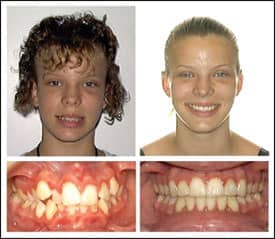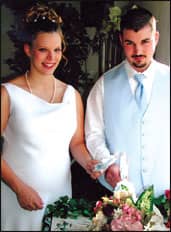by Alan Ruskin
With the help of caring orthodontists, this nonprofit organization seeks to go nationwide
 |
For some, “flashing a toothy grin” might not be the ticket to social success that the old saying implies. In fact, for those with serious malocclusions, misshapen teeth, damaged gums, and other dental problems, just opening their mouths can be more of an embarrassment than a joy.
This is especially the case for young people, who must contend with the often merciless taunts of their peers. Bad teeth can produce discrimination and feelings of low self-esteem. In addition to cosmetic issues, oral hygiene can also be negatively impacted.
The problem is particularly prevalent among youngsters from disadvantaged backgrounds, whose family history of low income has made access to good dental and health care chronically difficult. Who is there to help these already deprived kids go through life without the additional burden of a disfiguring smile, to enable them to take down the hand that they’ve learned to instinctively place in front of their mouths when speaking or meeting others, to give them a better shot at succeeding and enjoying life in more equal measure to their more economically fortunate counterparts?
The Name Says It All
Smiles Change Lives, Kansas City, Mo, is a nonprofit organization whose mission for the past 12 years has been to enable as many of these kids as possible to obtain the quality orthodontic care they so badly need, and which would otherwise be well beyond their reach. Founded in 1997 by Virginia Brown, a Kansas City philanthropist who grew up during the Great Depression and needed but had to wait to get her own braces, Smiles Change Lives (SCL) is now a national movement that includes more than 170 orthodontists, with another 1,500 or so in the pipeline.
According to Andrea Umbreit, MPA, marketing coordinator of SCL, “We provide life-changing essential orthodontic care to children from low-income families. We’re the link between those kids, who would never have had access to orthodontic treatment, and philanthropic orthodontists who are involved in the community and want to help. We find the orthodontists who care.”
Umbreit goes on to point out how the program appeals to the orthodontists. “Orthodontists seek us out because they want a turnkey program. They’re often hit up for pro bono care, but they don’t want to go through the screening process to see who is eligible. SCL takes care of that for them. We act as the middleman, compiling and processing applications, asking families to provide proof of income (families must meet the guideline of 200% poverty level or less), and documenting the applicants’ dental and oral hygiene history.”
The approval process is rigorous because there are many more applicants than can be accepted. A screening conducted in each chapter by an advisory board that includes a handful of orthodontists and others, including general and pediatric dentists, takes place within the applicant’s geographical area, often at a university dental school. The application process takes up to 12 months depending on various factors, including age (patients must be 11 to 18 years old), severity of the malocclusion, attendance at screening appointments, and verification of family income. The families are also required to contribute a fee of $200 toward the overall cost of treatment as an indication of their commitment and shared responsibility in the program.
 |
“The process isn’t always easy,” Umbreit says. “Sometimes the problem is too severe and we can’t help them. In that case, we refer them to other agencies that may be able to provide treatment.” On the other hand, Umbreit adds, “sometimes the malocclusion isn’t severe enough. Remember, our mission is to enable life-changing correction, not merely superficial cosmetic improvement.”
Just one out of 10 children makes it through the lengthy screening process to actually get braces, “but there’s no shortage of kids who need this,” Umbreit says. Statistically, she reports, “20 percent of all children have a moderate to severe malocclusion, with a disproportionate number among lower income families, and no less than 3 million kids in the US qualify for this program.”
Orthodontists in Action
Among the orthodontists who have agreed to take on the program’s requirement of treating at least three cost-free patients per year are Joe Hannah, DDS, and Jay M. Oltjen, DDS, MS, who share a practice in Overland Park, Kan.
“I’m so impressed with the Virginia Brown Foundation,” Hannah says. “To grow this thing like they have and make it a national organization is quite an achievement. A lot of orthodontists have been involved.”
Hannah recounts his first meeting with founder Virginia Brown and her son, SCL board president Tom Brown. “About 8 or 9 years ago I was fortunate enough to have dinner with them along with several other local orthodontists. All of us have had experience donating cases for charitable causes, but to be able to do it in a structured environment where patients are screened for us —and we know there’s a really big need—it’s nice to be involved in an organization like that.”
Hannah’s reward is the appreciation the patients have for the care they receive. “Many of them have waited a year or more while they go through screening. By the time they get into our office they’re thrilled to have treatment. We can tell them, ‘No hidden costs … everything is taken care of … just be here for your appointments.’ That’s great for them and a real good feeling for us.”
 |
| Before and after photos show how SCL orthodontists transformed the smile of a patient named Megan. |
Although Hannah treats all his patients equally and finds it difficult to separate one from another, he does relate the case of a young lady, LaDuska Johnson, who recently confided in him that it was frustrating for her to have to wait a year to be accepted into the program, and “she also wishes that there were more participating orthodontists, as she had to travel about 30 miles from her hometown, where, at the time, none of the three orthos were participating in the program.”
However, Hannah says, “LaDuska is very happy with her new smile. She had extreme dental crowding before treatment. She has told us that Smiles Change Lives was easy to work with, and she’s very grateful to be given the opportunity. We will continue to see her in retention, and she will always be a special patient who, due to Smiles Change Lives and our help, is proud of her smile.”
Hannah is also pleased that the orthodontists in the program decided to help things along by relieving SCL of the cost of paying the doctors about half of the total fee for each patient. “About a year ago we got together and told them to forget about paying us. We knew that fund-raising was hard and they were having to spend a lot of time and effort doing that. We’re very glad to help a group that can go about this necessary work in such an organized and efficient manner.”
Hannah’s associate, Jay M. Oltjen, DDS, MS, joined Hannah in their practice 13 years ago, and echoes his sentiments, saying, “What a great program. Everybody looks for ways they can help underprivileged people. The Brown family realized a great vision when they stepped forward with Smiles Change Lives.
“There is a definite need for this,” he continues. “Many of these kids have the deck stacked against them. This is one thing we can do for them. Nothing builds confidence like a great smile.”
To be admitted to the program, the children must have significant malocclusion problems, Oltjen says, “that left untreated will lead to wear on the teeth and other bite functions, and deterioration of dentition. Many also have psychological problems related to the cosmetic issues, hands hiding the mouth, and so on. These kids don’t have it made—if I can do one small thing to help, I feel better for it.”
Making It Easy to Do Good
Oltjen comments on what he refers to as the “creativity” of the program, explaining that prior to their involvement with SCL, he and Hannah would participate in the Kansas Medicare program, but “it was a real chore with all the paperwork and bureaucracy, whereas the Brown program is very clean, no state channels to have to go through and get bogged down in.”
Oltjen and Hannah both make every possible effort to purchase certain supplies and promotional products from the online store of SCL, called “Embrace Smiles.” “We know that the proceeds from that will help the kids. We would love to see the program expand to other areas. Their goal is to become more national, and so far they’ve been a really good model.”
 |
| Former SCL patient Megan smiles on her wedding day—her mother says a new smile made her “more confident and proud.” |
Like his partner, Oltjen gives much of the credit to their own staff. “The strength of our practice is our staff and their experience. When you add up the years—over 40 staff members at our eight locations with over 500 total years of experience, some of them with us for over 30 years—that’s a lot of well-trained and committed people. Our successful practice and enthusiastic participation in SCL is largely due to our staff.”
He concludes on a high note: “For Joe and me, we’re blessed to be able to have the skills to do what we do. I think we and our staff set a good example for Smiles Change Lives, and our reward is seeing these kids smile when their braces come off. You can’t beat that.”
Getting Involved
Smiles Change Lives has a current annual budget of about $500,000, with donations coming through the Virginia Brown Foundation and other sources. It takes approximately $20,000 to launch a chapter in a particular geographical area, and so far eight chapters—each with its own advisory board—have been established in such places as St Louis/eastern Missouri, Kansas City/western Missouri, Florida (Palm Beach and Broward/Dade counties), the states of Minnesota and Kentucky, and Long Island, NY. A chapter in the state of Virginia is almost ready to go, and another dozen chapters are in the works, with the intention to launch three to five of them this year. Marketing coordinator Umbreit says the future is bright, thanks especially to the support of SCL’s official orthodontics industry sponsor, 3M. “3M has helped with the fund-raising and has whole-heartedly embraced the SCL mission. Without gushing, they’re simply wonderful to work with.”
At this point there are only six people on staff at SCL—three full-time and three part-time, but more will certainly be added, Umbreit says, as the program expands.
Despite the current limitations in funding and personnel, SCL was able to place 317 youngsters in treatment in 2008. Other significant accomplishments for the year included landing the 3M sponsorship and eliminating the orthodontist payment, as well as receiving a commitment from Dolphin Imaging & Management Solutions to donate database and imaging software.
As for the interest level of orthodontists, Umbreit says, “A lot of docs have contacted us, asking, ‘What’s taking so long?’ They really want to get started.” She recommends a few things they can do to help move things along more quickly, like creating fund-raising events at their facilities, such as benefit walks and candy buy-backs. Another is purchasing promotional items, such as T-shirts and mugs, through the “Embrace Smiles” Web site, as well as publicizing the “Adopt a Smile” fund-raising campaign that seeks a $500 sponsor for each child who is approved for treatment.
“That $500 covers each patient from application through braces, and all the steps in between, as well as the nine out of 10 patients who don’t make it all the way through the screening process,” Umbreit remarks. She proudly adds that, “We have a 98 percent completion rate for all accepted patients, which is a rate not typically seen in social service programs, and we attribute that to our very efficient screening process.”
Umbreit is very happy with program participants Hannah and Oltjen, with whom she recently did a photo shoot involving new SCL patients. Of the two orthodontists, she says, “They are outstanding, always there when we need them.”
|
To read more articles on this topic, for “Smiles Change Lives”. |
“We have the kids, and we have the docs,” Umbreit says, emphatically. “All we need is more financing to continue to grow.”
Perhaps there could be no more fitting conclusion to this story than a letter and photo sent to SCL from Ann M, the mother of Megan (see photo at left). The letter reads: “Please pass this along to Mrs Brown and her family. My daughter, Megan, was a recipient of services from Smiles Change Lives. I thought that I would attach a photo of her from her wedding to show her BEAUTIFUL smile and what a beautiful bride she made. Thank you so much for the wonderful thing you did! It has truly impacted her life and made her a more confident and proud person. I truly believe that if she had not gotten braces she would not be the happy, healthy, vibrant person she is today! Thanks again for EVERYTHING!!”
Alan Ruskin is a staff writer for Orthodontic Products. Please send questions and comments to









